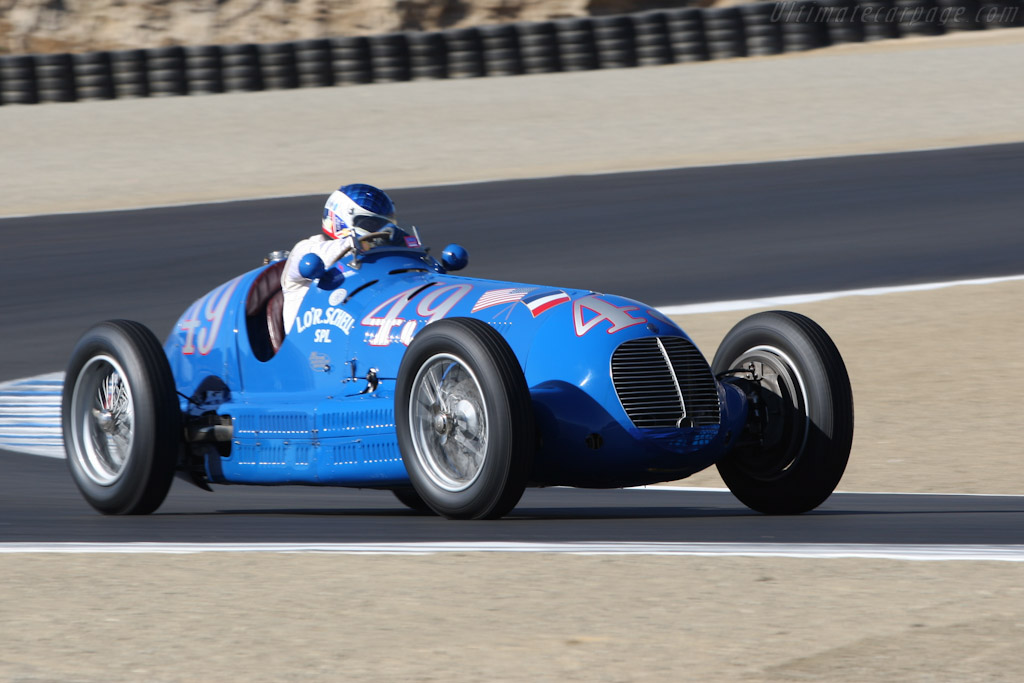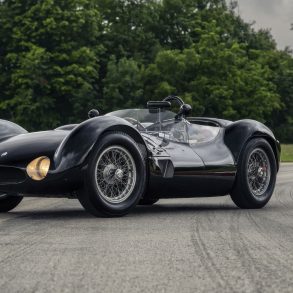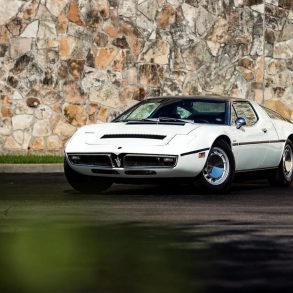Maserati 8CTF
Car: Maserati 8CTF/ Engine: Straight 8 / Maker: Maserati / Bore X Stroke: 69.0 mm (2.7 in) / 100.0 mm (3.9 in) / Year: 1938 / Capacity: 2,991 cc / 182.5 cu in / Class: Grand Prix / Power: 365 bhp / 272 KW @ 6,300 rpm / Wheelbase: 2,720 mm (107.1 in) / Track: Front: 1,340 mm (52.8 in) Rear: 1,360 mm (53.5 in) / Weight: 780 kilo / 1,720 lbs
Adolfo Orsi, an Italian industrialist, purchased the financially troubled Maserati company in 1937, employing his son, Omar Orsi as managing director and retaining three of the Maserati Brothers on ten-year contracts to the engineering team.
Starting in 1938 the regulations for Grand Prix cars would be drastically changed with maximum weight of 750 kg, replaced by a minimum weight depending on displacement, with a maximum of 3 litres for blown and 4.5 for naturally aspirated engines. Given their long experience with Superchargers, the Maserati brothers opted for the former. A new eight cylinder engine was developed based upon the engine in the 4CM 1500 voiturette car. Like that twin-cam engine, the 3 litre ‘eight’ used a fixed cylinder head or ‘testa fissa’, which also explains the 8CTF type indication. This setup allowed for higher compression ratios and did away with the need for the often vulnerable head gasket. Two Roots-Type Superchargers were bolted onto the nose of the engine. At the car’s debut, the big ‘eight’ produced 350 bhp which was later upgraded to 365 bhp.

The hydraulic assisted brakes sported magnesium drum brakes designed to disperse heat more easily and to be less prone to fading. The Maserati 8CTF was finished off with an aluminum body similar to that of the 6CM, with a longer nose required by the larger engine. The cars were always meant to be an interim car in anticipation of new regulations for the 1939 season.
Two 8CTFs were ready in time for the second Grand Prix of the season at Tripoli. There it faced the on paper superior Mercedes-Benz W154, which was a bit heavier, but powered by a 450+ bhp V12. Not boding well for the Maserati Works team either was the poor health of both drivers Achille Varzi and Count Trossi.
Starting from the second row, Trossi surprised the Germans and pleased the many Italians by closely chasing the leading Mercedes for several laps. After nine laps the gearbox let go, leaving an easy win for Herman Lang. Despite the great debut, the 8CTF was set aside to focus on building their successful voiturettes, which were in high demand. The 8CTFs were raced again at various locations, showing great pace, but poor reliability. Both the brakes and the engine proved to be prone to failure.
Little was done over the winter to fix the problems with Maserati’s engineers continuing to develop and construct their voiturettes. This was given even more priority when the organizers of the important Tripoli Grand Prix stated that it would be held for voiturette cars.
Success in America
At the 1937 Vanderbilt Cup race on Long Island Wilbur Shaw was astounded by the advanced European Grand Prix cars he encountered. Shaw sought out his friend Mike Boyle, and pointed to one of the Maseratis in the Roosevelt Raceway paddock and and told Boyle:
“If I had a car like that, I’d win the next 500-mile race in it.”
Boyle and his chief mechanic, Cotton Henning, found Maserati eager to do business in America, though through some breakdown in communication communication or otherwise the Italians first sent over a 91 cubic-inch 6CM voiturette, too small for the Brickyard. Finally Henning received a more appropriate 3.0-liter 8CTF. Boyle reportedly paid $15,000, several times what an American-built special cost. But the machine was shipped to America with pure water in the cooling system, which froze during the Atlantic passage and split the cylinder blocks, effectively turning the jewel-like engine into junk.
Henning, a master craftsman who could repair anything, carefully rebuilt the power plant, and once he and Shaw mastered the intricacies of engine preparation created a car that would prove a sensation at the Speedway. Outmatched by Mercedes and Auto Union and never a top contender on the GP circuits for which it was intended, the 8CTF seemed made for the Brickyard and the methanol fuel used there, a track the car’s designers had probably never laid eye is.
The Boyle Special became a part of Indianapolis history when Shaw won the 1939 Indianapolis 500 and again in 1940. At the latter race they were joined by two other Maseratis which had been sold to the Irish-American heiress Lucy O’Reilly Schell’s Ecurie Bleue and driven by René Le Bègue and René Dreyfus. Due to some miscommunication during qualifying only one of the Maseratis started the race coming from the 31st position to finish 10th. Shaw was well on his way to a third victory in 1941 when he crashed due to a bad wheel being mounted in error. Shaw had proved his point and chose not to compete at Indianapolis in the future. Louis Unser of the famous Unser family won the Pikes Peak Hillclimb in 1946 and 1947, driving an ex-Shell Maserati 8CTF. The Maseratis would continue to be raced in America into the next decade.




















